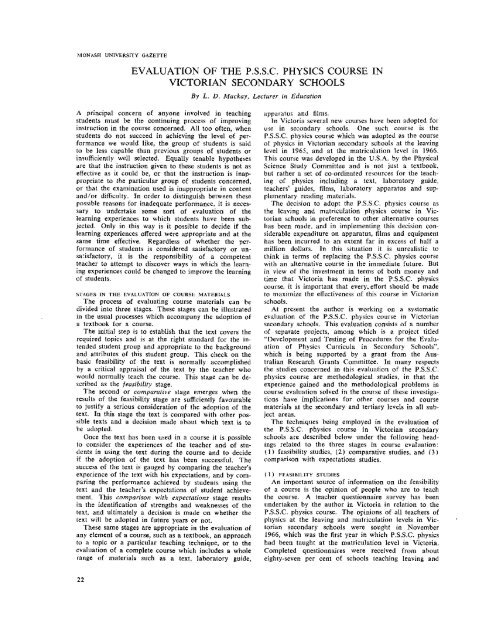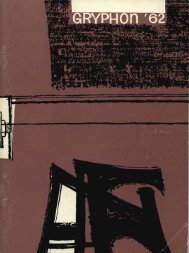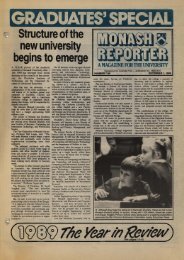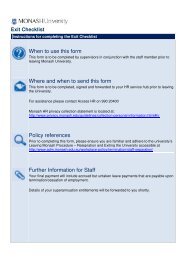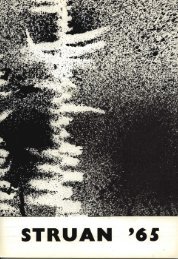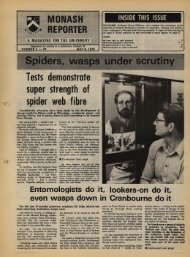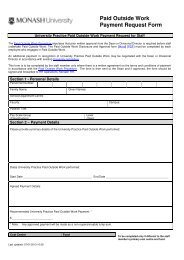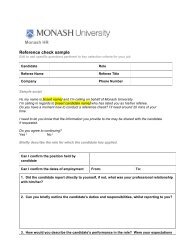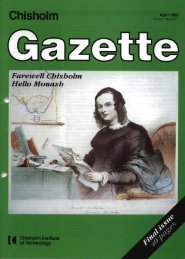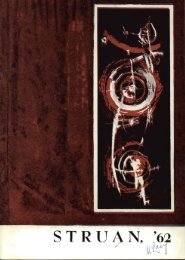GAZETTE - Adm.monash.edu.au - Monash University
GAZETTE - Adm.monash.edu.au - Monash University
GAZETTE - Adm.monash.edu.au - Monash University
- No tags were found...
Create successful ePaper yourself
Turn your PDF publications into a flip-book with our unique Google optimized e-Paper software.
MONASH UNIVERSITY <strong>GAZETTE</strong>EVALUATION OF THE P.S.S.c. PHYSICS COURSE INVICTORIAN SECONDARY SCHOOLSBy L. D. Mackay, Lecturer in EducationA principal concern of anyone involved in teachingstudents must be the continuing process of improvinginstruction in the course concerned. AU too often, whenstudents do not succeed in achieving the level of performancewe would like, the group of students is saidto be less capable than previous groups of students orinsufficiently well selected. Equally tenable hypothesesare that the instruction given to these students is not aseffective as it could be, or that the instruction is inappropriateto the particular group of students concerned,or that the examination used is inappropriate in contentand/or difficulty. In order to distinguish between thesepossible reasons for inadequate performance, it is necessaryto undertake some sort of evaluation of thelearning experiences to which students have been subjected.Only in this way is it possible to decide if thelearning experiences offered were appropriate and at thesame time effective. Regardless of whether the performanceof students is considered satisfactory or unsatisfactory,it is the responsibility of a competentteacher to attempt to discover ways in which the learningexperiences could be changed to improve the learningof students.STAGES IN THE EVALUATION OF COURSE MATERIALSThe process of evaluating course materials can bedivided into three stages. These stages can be illustratedin the usual processes which accompany the adoption ofa textbook for a course.The initial step is to establish that the text covers therequired topics and is at the right standard for the intendedstudent group and appropriate to the backgroundand attributes of this student group. This check on thebasic feasibility of the text is normally accomplishedby a critical appraisal of the text by the teacher whowould normally teach the course. This stage can be describedas the feasibility stage.The second or comparative stage emerges when theresults of the feasibility stage are sufficiently favourableto justify a serious consideration of the adoption of thetext. In this stage the text is compared with other possibletexts and a decision made about which text is tobe adopted.Once the text has been used in a course it is possibleto consider the experiences of the teacher and of studentsin using the text during the course and to decideif the adoption of the text has been successful. Thesuccess of the text is g<strong>au</strong>ged by comparing the teacher'sexperience of the text with his expectations, and by comparingthe performance achieved by students using thetext and the teacher's expectations of student achievement.This comparison with expectations stage resultsin the identification of strengths and weaknesses of thetext, and ultimately a decision is made on whether thetext will be adopted in future years or not.These same stages are appropriate in the evaluation ofany element of a course, such as a textbook, an approachto a topic or a particular teaching technique, or to theevaluation of a complete course which includes a wholerange of materials such as a text, laboratory guide,apparatus and films.In Victoria several new courses have been adopted foruse in secondary schools. One such course is theP.S.S.c. physics course which was adopted as the courseof physics in Victorian secondary schools at the leavinglevel in 1965, and at the matriculation level in 1966.This course was developed in the U.S.A. by the PhysicalScience Study Committee and is not just a textbook,but rather a set of co-ordinated resources for the teachingof physics including a text, laboratory guide,teachers' guides, films, laboratory apparatus and supplementaryreading materials.The decision to adopt the P.S.S.c. physics course asthe leaving and matriculation physics course in Victorianschools in preference to other alternative courseshas been made. and in implementing this decision considerableexpenditure on apparatus, films and equipmenthas been incurred to an extent far in excess of half amillion dollars. In this situation it is unrealistic tothink in terms of replacing the P.S.S.c. physics coursewith an alternative course in the immediate future. Butin view of the investment in terms of both money andtime that Victoria has made in the P .S.S.c. physicscourse, it is important that every. effort should be madeto maximize the effectiveness of this course in Victorianschools.At present the <strong>au</strong>thor is working on a systematicevaluation of the P.S.S.C. physics course in Victoriansecondary schools. This evaluation consists of a numberof separate projects, among which is a project titled"Development and Testing of Proc<strong>edu</strong>res for the Evaluationof Physics Curricula in Secondary Schools",which is being supported by a grant from the AustralianResearch Grants Committee. In many respectsthe studies concerned in this evaluation of the P.S.S.c.physics course are methodological studies. in that theexperience gained and the methodological problems incourse evaluation solved in the course of these investigationshave implications for other courses and coursematerials at the secondary and tertiary levels in all subjectareas.The techniques being employed in the evaluation ofthe P.S.S.c. physics course in Victorian secondaryschools are described below under the following headingsrelated to the three stages in course evaluation:( 1) feasibility studies, (2) comparative studies, and (3)comparison with expectations studies.( I) FEASIBILITY STUDIESAn important source of information on the feasibilityof a course is the opinion of people who are to teachthe course. A teacher questionnaire survey has beenundertaken by the <strong>au</strong>thor in Victoria in relation to theP.S.S.c. physics course. The opinions of all teachers ofphysics at the leaving and matriculation levels in Victoriansecondary schools were sought in November1966, which was the first year in which P.S.S.c. physicshad been t<strong>au</strong>ght at the matriculation level in Victoria.Completed questionnaires were received from abouteighty-seven per cent of schools teaching leaving and22


